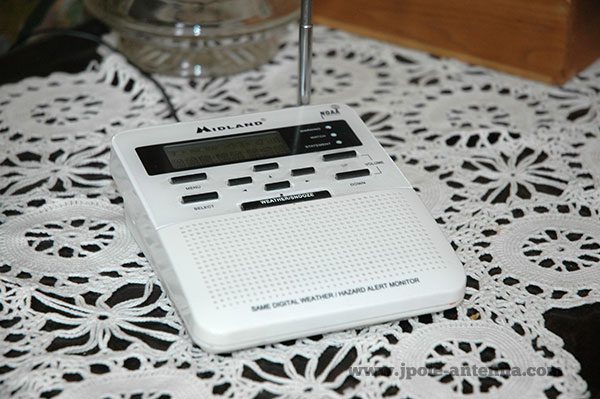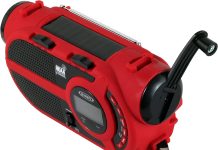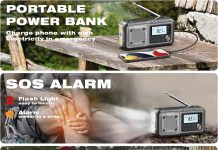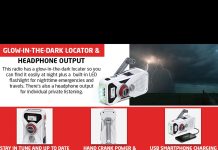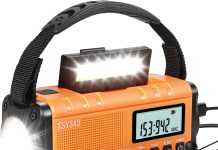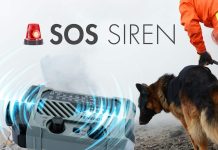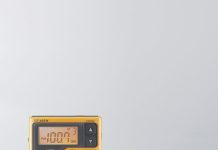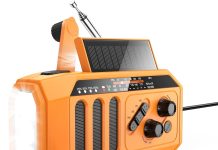Are you tired of having static-filled, unreliable reception on your NOAA weather radio? Look no further because this article has helpful tips and tricks to improve your NOAA weather radio reception.
From adjusting your antenna to finding the optimal location for your radio, we have all the information you need to enjoy clear and precise weather updates.
Say goodbye to fuzzy broadcasts and hello to crystal-clear reception so you never miss an essential weather alert again.
This image is the property of www.survivalsullivan.com.
Review contents
Antenna Placement
Elevate the antenna
When it comes to improving your NOAA weather radio reception, one of the first things to consider is the placement of your antenna. Elevating the antenna can significantly enhance the strength of the signal it receives.
By placing the antenna at a higher position, such as on a rooftop or in an attic, you can avoid obstructions and interference caused by buildings and other objects. Elevating the antenna helps it receive a more precise and robust signal, resulting in better reception of weather updates and emergency alerts.
Avoid obstructions
To maximize your NOAA weather radio reception, it is crucial to avoid placing your antenna near any obstructions. Obstructions can have a detrimental effect on the signal strength and quality.
Common obstructions include tall buildings, trees, mountains, and other large structures. These obstacles can block or interfere with the radio waves from the NOAA transmitter, causing weaker reception. Ensure your antenna is positioned to the transmitter in a clear line of sight to minimize obstructions and improve reception.
Extend the antenna
Another effective way to improve your NOAA weather radio reception is to extend the length of your antenna. Many NOAA weather radios come with a telescopic antenna that can be extended or adjusted.
By experimenting with the length of the antenna, you can find the optimal position for receiving the best signal. Extending the antenna fully or partially can increase the reception range and overall signal strength. Take the time to adjust and extend the antenna until you achieve the best reception possible.
Use an outdoor antenna.
Consider using an outdoor antenna for your NOAA weather radio. Outdoor antennas are specifically designed to provide better reception by being mounted on the exterior of your home or building.
Moving the antenna outside can often improve the signal quality and range. Outdoor antennas are typically more effective at avoiding obstructions, elevating the antenna, and receiving the NOAA transmitter’s signal directly. When using an outdoor antenna, comply with local regulations and follow proper installation guidelines for the best results.
Antenna Orientation
Adjust the direction
In addition to optimizing the placement of your antenna, adjusting its direction can also significantly impact your NOAA weather radio reception. The NOAA transmitter responsible for transmitting weather updates and emergency alerts is located in a specific direction relative to your location.
You can improve the reception quality by aligning your antenna towards the transmitter. Most antennas allow rotation, so try different directions until you find the one that provides the best signal strength.
Try different angles
The optimal antenna orientation is sometimes not straightforward due to the complex terrain or the surrounding environment. It’s worth experimenting with different angles to find the best reception in such cases.
Try angling the antenna slightly or even repositioning it to different sides. By changing the angle, you can minimize obstructions or interference affecting the signal quality. Keep testing different angles until you achieve the most reliable and consistent NOAA weather radio reception.
Location
Choose a better location.
The location of your NOAA weather radio can significantly impact its reception capabilities. If you are experiencing poor reception, consider moving the radio to a better location within your home or building.
Opt for a spot closer to a window or an exterior wall, as these areas typically provide better signal penetration. By selecting a better location, you can enhance the radio’s ability to receive the NOAA transmitter’s signals, improving reception and more reliable weather updates.
Relocate the radio
Sometimes, choosing a better location within the same building may not improve your NOAA weather radio reception. If you encounter persistent reception issues, relocating the radio to an entirely different building or area may be necessary.
Factors such as dense construction materials, distance from the NOAA transmitter, or electronic interference can limit the radio’s reception capabilities. Moving the radio to another location can help mitigate these obstacles and potentially provide a more robust and reliable signal.
Interference
Minimize electronic devices
Electronic devices can introduce interference that affects the performance of your NOAA weather radio. To improve reception, it is advisable to minimize the proximity of other electronic devices to your radio.
These devices include televisions, microwaves, computers, routers, and cordless phones. Try separating your radio from these devices, ideally by a few feet, to reduce the likelihood of interference. Minimizing electronic device proximity can improve signal quality and reduce potential disruptions to your NOAA weather radio reception.
Adjust nearby appliances
Certain household appliances generate electromagnetic interference that can impede your NOAA weather radio reception. Common culprits include refrigerators, fluorescent lights, and electrical motors.
If possible, adjust the position of these appliances or move your radio away from them to minimize interference. Experiment with different positions to find the setup that minimizes electrical disruptions and maximizes your NOAA weather radio reception. Remember, the goal is to reduce interference and achieve the most precise and robust signal possible.
Reduce electrical interference
Apart from adjusting nearby appliances, there are other steps you can take to minimize electrical interference that can affect your NOAA weather radio reception. Consider using surge protectors or power filters to reduce electrical noise and interference in your vicinity.
These devices can help maintain a clean electrical environment and enhance the overall reception quality of your radio. Additionally, ensure that all electrical connections are secure and properly grounded to prevent unwanted interference. You can optimize your NOAA weather radio reception by reducing electrical interference for more precise weather updates and emergency alerts.
This image is the property of www.jpole-antenna.com.
Weather Conditions
Stay aware of atmospheric conditions.
Weather conditions can influence the performance of your NOAA weather radio. Be aware of atmospheric conditions in your area and how they may affect your radio’s reception. Thunderstorms, heavy rainfall, and dense fog can limit the radio waves’ ability to reach your antenna.
You may experience temporary difficulties in receiving a strong signal in these situations. Stay informed about current and upcoming weather conditions and be patient during challenging atmospheric situations, as reception can often improve once the adverse weather passes.
Check for storm activity.
Monitoring accurate and timely weather updates is vital during severe weather events. If you live in an area prone to storms or severe weather conditions, make it a habit to check for storm activity regularly. Tune in to your NOAA weather radio during storm alerts and updates to stay informed and take appropriate action.
While weather radios are designed to provide reliable reception, challenging weather conditions may affect signal quality. Therefore, paying close attention to storm activity and keeping your radio in optimal condition is crucial for receiving critical weather information.
Radio Settings
Tune to the correct frequency.
Ensuring you have correctly tuned your NOAA weather radio to the appropriate frequency is essential for optimal reception. NOAA weather radio operates in the VHF frequency range, typically around 162.400 to 162.550 MHz.
Consult your radio’s manual or online resources to identify the correct frequency range for your specific model. Accurate tuning guarantees you receive the intended weather broadcasts and emergency alerts without distortions or reception issues.
Disable standby mode
Some NOAA weather radios have a standby or sleep mode feature that allows them to conserve power. While this feature can be helpful in certain situations, it can disrupt your reception.
Check your radio’s settings and ensure the standby mode is disabled, especially if you are experiencing reception problems. By keeping the radioactive and ready to receive signals at all times, you can maximize your chances of receiving clear and uninterrupted NOAA weather updates.
Adjust squelch
Squelch is a setting on your NOAA weather radio that helps eliminate background noise when no signal is received. Adjusting the squelch control allows you to fine-tune the sensitivity of your radio to receive only the desired NOAA broadcasts.
Set the squelch to a level that suppresses excessive noise but effectively captures the weather updates and alerts. Experiment with the squelch setting to find the optimal balance between reducing unwanted noise and maintaining a strong and clear signal.
This image is the property of www.jpole-antenna.com.
Signal Booster
Consider a signal amplifier.
If your NOAA weather radio reception is consistently weak or unreliable, you may want to consider using a signal amplifier or booster. Signal amplifiers are devices that boost the strength of the incoming signal, potentially improving reception quality.
These devices are often used in areas with weak signals or a long distance from the NOAA transmitter. Before purchasing a signal booster, ensure compatibility with your radio and seek advice from technical experts or knowledgeable professionals to determine the appropriate amplifier for your situation.
Use an external antenna.
An external antenna alongside your NOAA weather radio can also enhance reception performance. External antennas are designed to capture radio wave signals more efficiently, providing improved signal strength and coverage. Consult your radio’s manual or contact the manufacturer for information on compatible external antennas.
When installing an external antenna, follow the instructions carefully, ensuring secure mounting and proper connections for optimal signal reception. You can significantly boost your NOAA weather radio’s reception capabilities by supplementing your internal antenna with an external one.
Battery Power
Ensure proper battery strength.
If your NOAA weather radio operates on battery power, it is crucial to ensure the batteries are in good condition and have sufficient charge. Low battery power can weaken the radio’s ability to receive and process signals effectively.
Regularly check the battery status of your radio and replace it as needed to maintain optimal performance. Keeping spare batteries on hand is also a good practice to ensure uninterrupted reception, especially during power outages or other emergencies.
Replace old batteries
Over time, batteries can lose their charge capacity and become less efficient. If you have been using the same set of batteries for an extended period, it may be time to replace them.
Old batteries can lead to weak radio performance and deteriorated reception quality. Make it a habit to check and replace the batteries regularly to guarantee reliable reception and ensure that your NOAA weather radio is always ready to receive important weather updates and emergency alerts.
This image is the property of www.jpole-antenna.com.
Radio Maintenance
Keep the radio clean.
Regular maintenance and cleanliness are essential for the optimal performance of your NOAA weather radio. Dust, dirt, and debris can accumulate on the antenna and other radio parts, potentially affecting signal reception.
Clean the radio regularly using a soft cloth and mild cleaning agents suitable for electronic devices. Avoid using abrasive materials that may damage the radio’s surface or components. Keeping your radio clean and free of obstructions helps maintain clear and uninterrupted NOAA weather radio reception.
Regularly inspect for damage.
Performing routine inspections of your NOAA weather radio helps identify potential damage or issues affecting reception. Check the antenna for any signs of wear or physical damage. Examine the radio’s connectors, ports, and controls for loose or broken parts.
If you notice any damage, consider contacting the manufacturer or seeking professional assistance for repair or replacement. Early detection of damaged components ensures your radio operates optimally, guaranteeing reliable reception of weather updates and emergency alerts.
Technical Support
Contact NOAA or the manufacturer.
Suppose you have exhausted the tips above and still experience persistent reception issues. In that case, it is advisable to contact the National Oceanic and Atmospheric Administration (NOAA) or the manufacturer of your NOAA weather radio.
They can provide expert guidance and technical support specific to your radio model. Contact information for NOAA and the manufacturer can usually be found in the product manual or on their websites. Don’t hesitate to ask for assistance when all other troubleshooting efforts have failed.
Seek professional assistance
In some cases, if you live in an area with challenging reception conditions or have complex radio setup requirements, seeking professional assistance may be the best. Professional antenna installers or technicians can evaluate your situation, recommend appropriate equipment, and provide optimal placement.
Their expertise and experience can help overcome any reception challenges you may encounter. Contact licensed professionals specializing in antenna installation and signal optimization to get the best possible NOAA weather radio reception in your area.
Following these guidelines and implementing the suggested methods can significantly enhance your NOAA weather radio reception. Reliable reception is crucial for staying informed about weather updates and emergency alerts.
Whether optimizing your antenna placement, minimizing interference, or ensuring proper maintenance, improving your NOAA weather radio’s reception will contribute to your safety and preparedness during severe weather events.
This image is the property of www.savenetradio.org.





